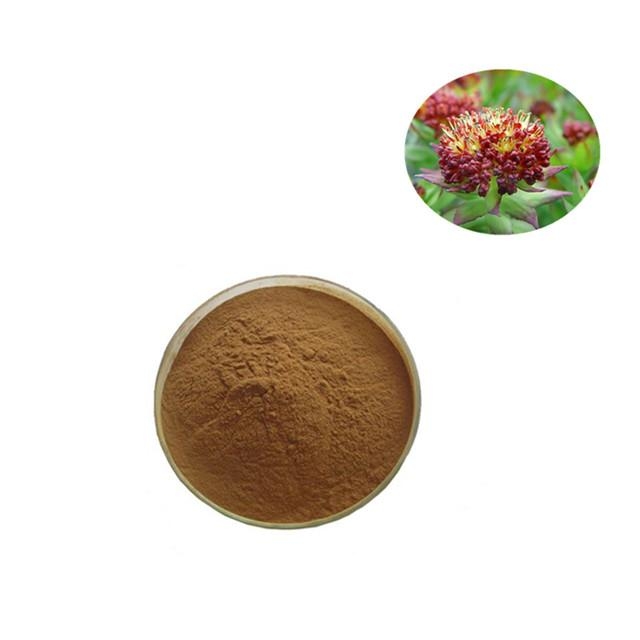
紅景天提取物
產品名稱: 紅景天提取物
拉丁名: Rhodiola Rosea
CAS號.: 10338-51-9
有效成分:紅景天甙,洛塞維
規格: 1% 2% 3%
檢測方式: HPLC
外觀: 棕褐色粉末

紅景天提取物是紅景天根部的提取物,氣香甜、味苦澀。主要成份為紅景天苷和甙元酪醇、絡塞維,具有增強免疫功能、保護心腦血管及 抗抑鬱的功效。
紅景天提取物
植物來源:本產品為景天科植物紅景天(Rhodiola rosea L.)的乾燥根莖。
外觀:淡黃色或棕紅色粉末
有效成分:紅景天甙,羅塞維
規格:紅景天甙1%-10%,羅塞維1%-10%
檢測方法:HPLC
CAS 編號:紅景天甙 10338-51-9 ,羅塞維84954-92-7
分子式:紅景天甙 C14H20O7 , 羅塞維C20H28O10
分子量:紅景天甙300.304 , 羅塞維428.4303
紅景天甙羅塞維
包裝:25公斤/桶
儲存:陰涼乾燥處存放
保質期:2年
用途:具有提高機體免疫力,增強體質,改善人體造血機能,抗缺氧,抗衰老,抗腫瘤,抗疲勞,降血糖,抗病毒,抗放射,預防高原反應等多種功能。
產品詳詢:13657416805
References:
- 1.Perfumi M., Mahioli L., Adaptogenic and CNS effects on single dose of 3% rosavin and 1% salidroside Rhodiola rosea L. extract in mice, Phytother Res, 2007, 21, 37–43
- 2.Qu ZQ., Zhou Y., Zeng YS., Li Y., Cheng Pl., Pretreatment with Rhodiola rosea extract reduces cognitive impairment induced by intracerebrovascular streptozotocin in rats: implication of anti-oxidative and neuroprotective effects, Biomedical and Enviromental Science, 2009, 22, 318–326
- 3.Panossian A., Wilkman G., Sarris J., Rosenroot (Rhodiola rosea): traditional use, chemical composition, pharmacology and clinical efficacy, Phytomedicine, 2010, 7, 481–493
- 4.Elamen A., Dragland S., Klemsdal SS., Bioactive compounds produced by clones of Rhodiola rosea maintained in the Norwegian germplasm collection, Pharmazie, 2010, 65, 618–23
- 5.Staneva J., Todorova M., Neykov N., Evstatieva L,. Ultrasonically assisted extraction of total phenols and flavonoids from Rhodiola rosea, Natural Product Communications, 2009, 4, 935–938
- 6.Khakpai F., Nasehi M., Haeri-Rohani A., Eidi A., Zarrindast MR., Scopolamine induced memory impairment; possible involvement of NMDA receptors mechanisms of dorsal hippocampus and/or septum, Behavioral Brain Research, 2012, 231, 1–10
- 7.Park SJ., Kim DH., Jung JM., Kim JM., Cai M., Liu X., et al, The ameliorating effects of stigmasterol on scopolamine-induced memory impairments in mice, Europian Journal of Pharmacology, 2012, 676, 64–70
- 8.Knox LT., Jing Y., Fleete MS., Collie VD., Zhang H., Liu P., Scopolamine impairs behavioral function and arginine metabolism in the rat dentate gyrus, Neuropharmacology, 2011, 61, 1452–1462
- 9.Klinkenberg I., Blokland A., A comparison of scopolamine and biperiden as a rodent model for cholinergic cognitive impairment, Psychopharmacology (Berl), 2011, 15, 549–566
- 10.Evstatieva L., Todorova M., Antonova D., Quality control of extracts of Rhodiola rosea L. based on the content of salidroside and rosavines, Proc, 5 CMAPSEEC, 2011, 208, 2–5
- 11.Evstatieva L., Todorova M., Antonova D., Staneva J., Chemical composition of the essential oils of Rhodiola rosea L. of three different origins, Pharmacognosy Mag, 2010, 6, 256–258
- 12.Kesner RP., Churchwell JC., An Analysis of rat prefrontal cortex in mediating executive functions, Neurobiol, Learn, Memory, 2011, 96, 417–31
- 13.Shi TY., Feng SF., Xing JH., WU JM., Li XQ., Zhang N., et al, Neuroprotective effects of salidroside and its analogue tyrosol galactoside against focal cerebral ischemia in vivo and h(2)o (2)-induced neurotoxicity in vitro, Neurotox Res, 2012, 21, 358–367
- 14.Tulsawani B., Meena DK., Shukla H., Sharma P., Meena RV., Gupta V., et al., Ninety days of repeated gavage administration of Rhodiola extract in rats, J Appl Toxicology, 2011, 10, 1009–1015
- 15.Petkov VD., Yonkov D., Mosharoff A., Kambourova T., Alova L., Petkov VV., et al, Effects of alcohol aqueous extract from Rhodiola rosea L. roots on learning and memory, Acta Physiol Pharmacol Bulg, 1986, 12, 3–16
- 16.Huang SC., Lee FT., Kuo TY., Yang JH., Chien CT., Attenuation of long-term Rhodiola rosea supplementation on exhaustive swimming evoked oxidative stress in the rat, Chin J Physiol, 2009, 52, 316–324
- 17.Brito GH., Davis BJ., Stopp LC., Stanton NE., Memory and septo-hippocampal cholinergic system in the rat, Psychopharmacology (Berlin), 1983, 81, 315–20
- 18.Falsafi SK., Deli A., Höger H., Pollak A., Lubec G., Scopolamine administration modulates muscarinic, nicotinic and NMDA receptor system, PLoS ONE, 2012, 7, e32082
- 19.Wiedenfield H., Dumaa M., Malinowski M., Furmanowa M., Naratuya S., Phytochemical and analytical studies of extracts from Rhodiola rosea and Rhodiola quadrifolia, Pharmazie, 2007, 64, 308–11.
- 20.Edwards D., Heufelder A., Zimmermann A., Therapeutic effects and safety of Rhodiola rosea extract WS 1375 in subjects with life-stress symptoms-results of an open-label study, Phythother Res, 2012